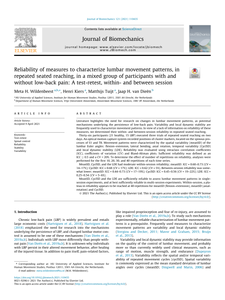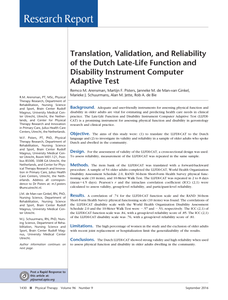Literature highlights the need for research on changes in lumbar movement patterns, as potential mechanisms underlying the persistence of low-back pain. Variability and local dynamic stability are frequently used to characterize movement patterns. In view of a lack of information on reliability of these measures, we determined their within- and between-session reliability in repeated seated reaching. Thirty-six participants (21 healthy, 15 LBP) executed three trials of repeated seated reaching on two days. An optical motion capture system recorded positions of cluster markers, located on the spinous processes of S1 and T8. Movement patterns were characterized by the spatial variability (meanSD) of the lumbar Euler angles: flexion–extension, lateral bending, axial rotation, temporal variability (CyclSD) and local dynamic stability (LDE). Reliability was evaluated using intraclass correlation coefficients (ICC), coefficients of variation (CV) and Bland-Altman plots. Sufficient reliability was defined as an ICC ≥ 0.5 and a CV < 20%. To determine the effect of number of repetitions on reliability, analyses were performed for the first 10, 20, 30, and 40 repetitions of each time series. MeanSD, CyclSD, and the LDE had moderate within-session reliability; meanSD: ICC = 0.60–0.73 (CV = 14–17%); CyclSD: ICC = 0.68 (CV = 17%); LDE: ICC = 0.62 (CV = 5%). Between-session reliability was somewhat lower; meanSD: ICC = 0.44–0.73 (CV = 17–19%); CyclSD: ICC = 0.45–0.56 (CV = 19–22%); LDE: ICC = 0.25–0.54 (CV = 5–6%). MeanSD, CyclSD and the LDE are sufficiently reliable to assess lumbar movement patterns in single-session experiments, and at best sufficiently reliable in multi-session experiments. Within-session, a plateau in reliability appears to be reached at 40 repetitions for meanSD (flexion–extension), meanSD (axial-rotation) and CyclSD.
MULTIFILE

Purpose Non-technical skills have gained attention, since enhancement of these skills is presumed to improve the process of trauma resuscitation. However, the reliability of assessing non-technical skills is underexposed, especially when using video analysis. Therefore, our primary aim was to assess the reliability of the Trauma Non-Technical Skills (T-NOTECHS) tool by video analysis. Secondarily, we investigated to what extent reliability increased when the T-NOTECHS was assessed by three assessors [average intra-class correlation (ICC)] instead of one (individual ICC). Methods As calculated by a pre-study power analysis, 18 videos were reviewed by three research assistants using the T-NOTECHS tool. Average and individual degree of agreement of the assessors was calculated using a two-way mixed model ICC. Results Average ICC was ‘excellent’ for the overall score and all five domains. Individual ICC was classified as ‘excellent’ for the overall score. Of the five domains, only one was classified as ‘excellent’, two as ‘good’ and two were even only ‘fair’. Conclusions Assessment of non-technical skills using the T-NOTECHS is reliable using video analysis and has an excellent reliability for the overall T-NOTECHS score. Assessment by three raters further improve the reliability, resulting in an excellent reliability for all individual domains.
DOCUMENT

Background. Adequate and user-friendly instruments for assessing physical function and disability in older adults are vital for estimating and predicting health care needs in clinical practice. The Late-Life Function and Disability Instrument Computer Adaptive Test (LLFDICAT) is a promising instrument for assessing physical function and disability in gerontology research and clinical practice. Objective. The aims of this study were: (1) to translate the LLFDI-CAT to the Dutch language and (2) to investigate its validity and reliability in a sample of older adults who spoke Dutch and dwelled in the community. Design. For the assessment of validity of the LLFDI-CAT, a cross-sectional design was used. To assess reliability, measurement of the LLFDI-CAT was repeated in the same sample. Methods. The item bank of the LLFDI-CAT was translated with a forward-backward procedure. A sample of 54 older adults completed the LLFDI-CAT, World Health Organization Disability Assessment Schedule 2.0, RAND 36-Item Short-Form Health Survey physical functioning scale (10 items), and 10-Meter Walk Test. The LLFDI-CAT was repeated in 2 to 8 days (mean4.5 days). Pearson’s r and the intraclass correlation coefficient (ICC) (2,1) were calculated to assess validity, group-level reliability, and participant-level reliability. Results. A correlation of .74 for the LLFDI-CAT function scale and the RAND 36-Item Short-Form Health Survey physical functioning scale (10 items) was found. The correlations of the LLFDI-CAT disability scale with the World Health Organization Disability Assessment Schedule 2.0 and the 10-Meter Walk Test were .57 and .53, respectively. The ICC (2,1) of the LLFDI-CAT function scale was .84, with a group-level reliability score of .85. The ICC (2,1) of the LLFDI-CAT disability scale was .76, with a group-level reliability score of .81. Limitations. The high percentage of women in the study and the exclusion of older adults with recent joint replacement or hospitalization limit the generalizability of the results. Conclusions. The Dutch LLFDI-CAT showed strong validity and high reliability when used to assess physical function and disability in older adults dwelling in the community.
MULTIFILE

Inleiding en praktijkvraag Het in 2012 opgerichte Saxion lectoraat Mechatronica is destijds gestart met het genomineerde RAAK-PRO project Medical Robotics. De ontwikkelde mechatronische kennis (vision, autonome navigatie, robotarmen) zijn enkel toegepast in de zorg en service robotica, maar kan worden toegepast in de industrie. Noord-oost Nederland staat bekend om zijn HTSM industrieën (VMI, WWINN, Bronkhorst, AWL, Norma, Thales, ed) en deze willen concreet en projectmatig samenwerken met kennisinstellingen binnen een netwerk van bedrijven. Projectdoelstelling Doelstelling is om met een breed netwerk van bedrijven de gezamenlijke onderzoeksbehoefte te identificeren. Diverse bedrijven, waaronder IMS en MetricControl, hebben reeds concreet hierom gevraagd. De doelstelling van het project BOARDing (“come-on-board”) is dan ook: “Identificeren van de gezamenlijke onderzoeksbehoefte en projectmatig deze samen op te lossen met de kennisinstellingen”. De hoofddoelstelling wordt beantwoord door de deliverables uit de volgende subdoelstellingen: 1. (her-)oprichten van de Mechatronica Vally Twente 2. Definitie gezamenlijke onderzoeksroadmap vanuit de individuele technologie roadmaps 3. Nieuwe onderzoeksprojectvoorstellen (min 1) uit deze onderzoeksroadmap. Bijdrage aan topsector SMART Industry Het lectoraat en de deelnemende bedrijfspartners IMS en MetricControl willen bewerkstelligen dat er concreet en projectmatig daadwerkelijke invulling wordt gegeven aan de regionale kennisagenda van de topsector SMART Industry: “Boost – Actieagenda Smart Industry Oost-Nederland”1. Projectmatig samenwerken en kennisdeling binnen de (her-)op te richten stichting Mechatronia voor een lange duur is daarbij de gezamenlijke visie. Vraagsturing, Netwerkvorming & Bijdrage aan innovatie Reeds 8 bedrijven hebben gevraagd om een gezamenlijke onderzoeksroadmap en zichzelf verplicht tot actieve onderzoeks- en kennisdeelname en streeft, onder deze voorwaarde, een groeimodel na in het geloof dat gezamenlijke onderzoek kosteneffectief is en de innovatie wordt gestimuleerd door onderlinge kennisontwikkeling en kennisdeling. Activiteitenplan & Projectorganisatie Het project wordt met name uitgevoerd door de lector Dr. Ir. D.A.Bekke en de deelnemende CEO’s van IMS en MetricControl.
Since March 2013, Paul Peeters is a member of the ICAO/CAEP Working Group 3, which is responsible for setting a new fuel efficiency standard for of civil aviation. He does so for the International Coalition for Sustainable Aviation (ICSA). ICSA was established in 1998 by a group of national and international environmental NGOs as official observers. Since its inception, ICSA has contributed to CAEP’s work on technical means to reduce emissions and noise, the role of market-based measures, supporting economic and environmental analysis, modelling and forecasting, and ICAO’s carbon calculator. It has also been invited to present its views at ICAO workshops on carbon markets and bio-fuels, and has presented to the high-level Group on Internation Aviation and Climate Change (GIACC). ICSA uses the expertise within its NGO membership to formulate its co-ordinated positions. To gain the broadest level of understanding and input from environmental NGOs, ICSA communicates with, and invites comment from, other NGO networks and bodies working in related areas. ICSA’s participation in ICAO and CAEP meetings is currently provided by the Aviation Environment Federation (AEF), the International Council for Clean Transportation (ICCT) and Transport and Environment (T&E). See http://www.icsa-aviation.org
INXCES will use and enhance innovative 3D terrain analysis and visualization technology coupled with state-of-the-art satellite remote sensing to develop cost-effective risk assessment tools for urban flooding, aquifer recharge, ground stability and subsidence. INXCES will develop quick scan tools that will help decision makers and other actors to improve the understanding of urban and peri-urban terrains and identify options for cost effective implementation of water management solutions that reduce the negative impacts of extreme events, maximize beneficial uses of rainwater and stormwater for small to intermediate events and provide long-term resilience in light of future climate changes. The INXCES approach optimizes the multiple benefits of urban ecosystems, thereby stimulating widespread implementation of nature-based solutions on the urban catchment scale.INXCES will develop new innovative technological methods for risk assessment and mitigation of extreme hydroclimatic events and optimization of urban water-dependent ecosystem services at the catchment level, for a spectrum of rainfall events. It is widely acknowledged that extreme events such as floods and droughts are an increasing challenge, particularly in urban areas. The frequency and intensity of floods and droughts pose challenges for economic and social development, negatively affecting the quality of life of urban populations. Prevention and mitigation of the consequences of hydroclimatic extreme events are dependent on the time scale. Floods are typically a consequence of intense rainfall events with short duration. In relation to prolonged droughts however, a much slower timescale needs to be considered, connected to groundwater level reductions, desiccation and negative consequences for growing conditions and potential ground – and building stability.INXCES will take a holistic spatial and temporal approach to the urban water balance at a catchment scale and perform technical-scientific research to assess, mitigate and build resilience in cities against extreme hydroclimatic events with nature-based solutions.INXCES will use and enhance innovative 3D terrain analysis and visualization technology coupled with state-of-the-art satellite remote sensing to develop cost-effective risk assessment tools for urban flooding, aquifer recharge, ground stability and subsidence. INXCES will develop quick scan tools that will help decision makers and other actors to improve the understanding of urban and peri-urban terrains and identify options for cost effective implementation of water management solutions that reduce the negative impacts of extreme events, maximize beneficial uses of rainwater and stormwater for small to intermediate events and provide long-term resilience in light of future climate changes. The INXCES approach optimizes the multiple benefits of urban ecosystems, thereby stimulating widespread implementation of nature-based solutions on the urban catchment scale.